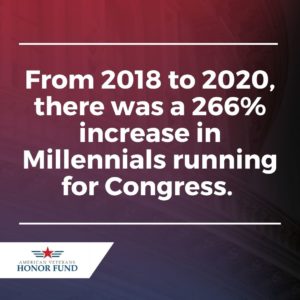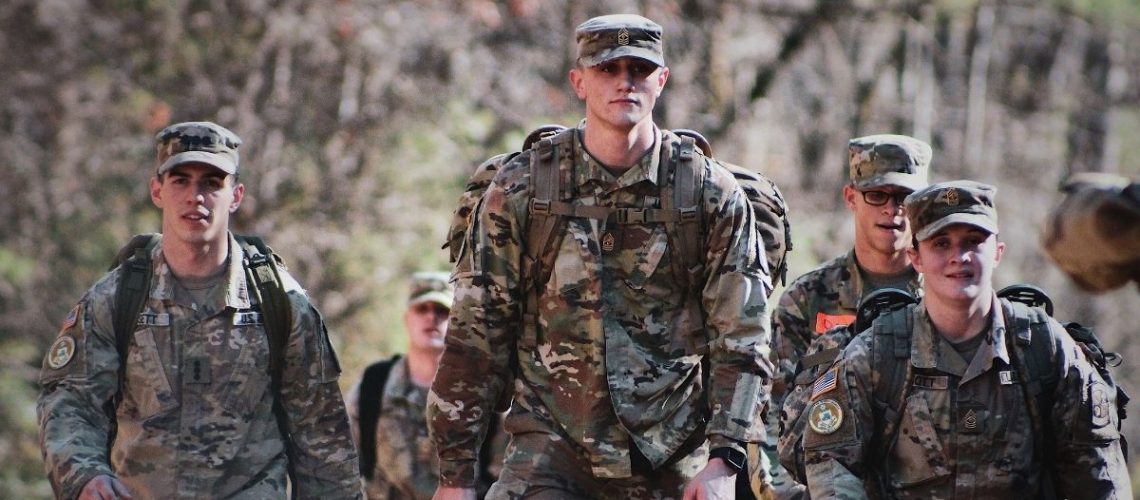The 2020 Elections were a watershed moment for millennials looking to enter the world of Congressional politics. As we watch as established politicians cling to power for decades, a new generation is rising up the ranks to challenge them for their seats. This last election cycle is an indication of how future elections may look. That will likely mean younger and perhaps even greater Veteran representation as those who served in the post 9/11 military begin to enter the fray.
When trying to piece together the scope of Millennial candidate participation in last year’s election process, The Millennial Action Project is an indispensable tool. Not only have they released a report which aggregates the numbers, but they all have a great list name of each Millennial Candidate who ran. They found the following:
- 236 candidates running for Congress in November are under the age of 45. Of those, 123 are “true” Millennials born between 1979 and 1996. For comparison, 103 “true” Millennials were on November ballots in 2018.
- From 2018 to 2020, there was a 266% increase in Millennials running for Congress. In 2020, MAP has tracked 703 Millennial candidates for Congress throughout this cycle, compared to just 264 in 2018.
- Of the 236 candidates running for Congress under the age of 45, 141 are Democrats, 92 are Republicans, two are Independents, and two are Libertarians.
- Of the 236 candidates running for Congress under the age of 45, 97 are women and 139 are men.
Another notable trend in last year’s election cycle was the record number of non-white males running for Congressional office. Indeed, if last year is any indication, it appears that future elections will likely have a far greater diversity of backgrounds than in elections past. This includes women, and particularly, women of color.
British publication, The Guardian, noted that:
“An unprecedented 318 women are running as Democratic or Republican candidates for the 470 seats available across the House of Representatives and the Senate, up from a previous record of 257 set in 2018.
Of those candidates 117 are women of color, building on the midterm elections of two years ago which saw high-profile women such as Alexandria Ocasio-Cortez, in New York, and Ilhan Omar, in Minnesota, elected.“
Females running for Congress have seen an uptick in recent elections and the last election cycle in 2018 resulted in the most female Veterans serving in Congressional history!

The Department of Veterans Affairs official government blog, VAntage Point, noted in 2019 that:
“As the number of women in military service grows, so does the number of women Veterans. Today, nearly 2 million Veterans are women. As the fastest growing Veteran subpopulation, women Veterans are making their mark. Before 2012, there had been only three women Veterans in Congress in history. Today, a record six female Veterans hold office on Capitol Hill.“
In total, there were 28 female Veterans running for Congress last year. 24 of whom for House seats and 4 ran for Senate seats.
The case of Gina Ortiz Jones may be one of the greatest testaments to the level of diversity which has grown in American politics in recent years.
One pro-Veteran blog, Connecting Vets, noted the following:
“Gina Ortiz Jones, a former Air Force captain and veteran of the Iraq War where she served as an intelligence officer, is the Democrat candidate running to replace Rep. Will Hurd, R-Texas, who defeated her in the 2018 election. Ortiz Jones is a lesbian and served under “Don’t Ask Don’t Tell” during her time in the Air Force.“
While Ortiz Jones did not win her seat, she recently made history in President Biden’s Administration, as the country’s first openly lesbian Undersecretary of the United States Air Force.
Ultimately it seems that the trend in who is running for office reflects the embrace of diversity and inclusion that the Pentagon has recently made declarations of commitment to as a top priority of our armed forces. There has never been a better time for female or minority Veterans to throw their hats into the ring. This is especially true for Millennial Veterans. As this organization has noted in a previous post, “2020 brought double digit Millennial representation in Congress for the first time ever, and they are more likely to be Veterans than any other demographic in Congress.” While the numbers of Veterans serving in Congress in recent decades has declined, the Millennial generation appears poised to reverse this trend, and we certainly hope they do!
Image Credit: Photo by Scandinavian Backlash on Unsplash
While there may be fewer Veteran candidates running for Congress in recent decades, the ones who do run have still found notable success at the ballot box in recent decades. But where are they most successful?


